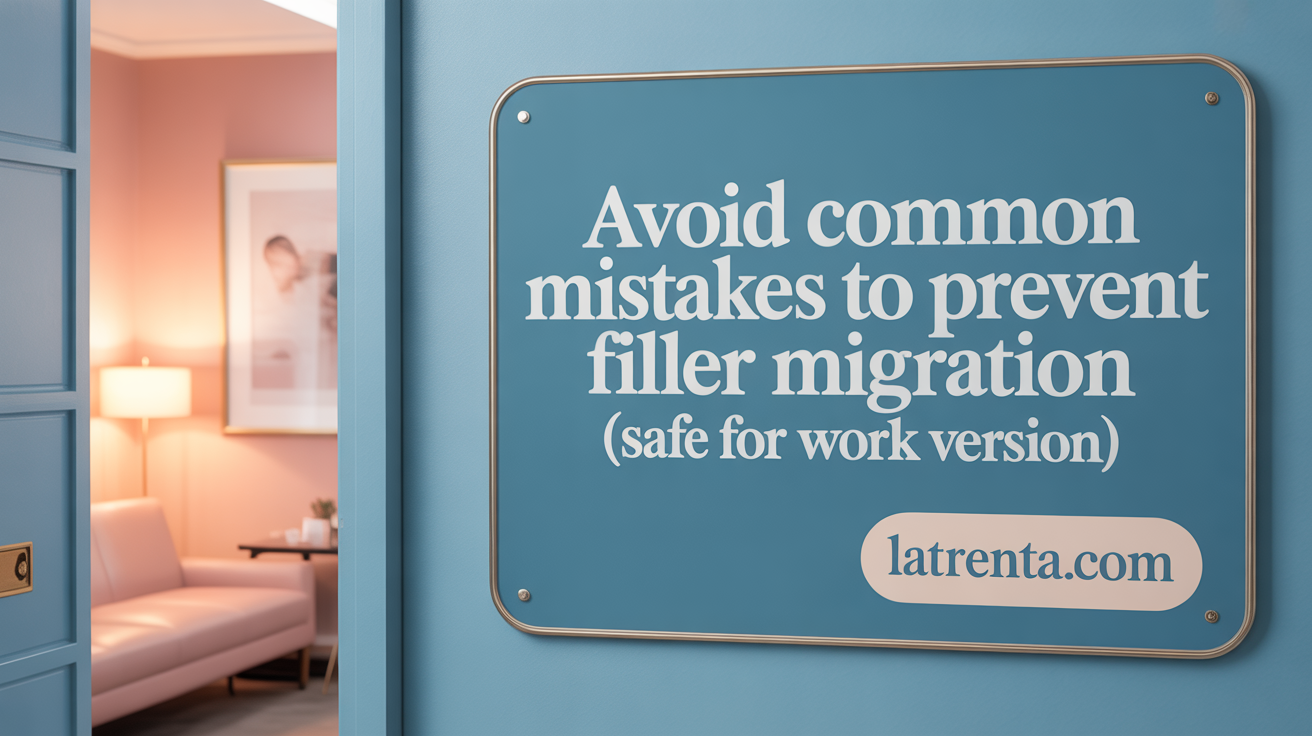Introduction to Filler Migration
Dermal fillers have become a popular solution for facial enhancement and rejuvenation. However, one of the less commonly discussed yet important complications is filler migration. This phenomenon occurs when injected filler shifts from its original placement causing aesthetic distortions or lumps. While filler migration is relatively rare, understanding its causes, risk factors, symptoms, and treatment options is crucial for anyone considering or managing filler treatments. This article delves into what causes filler migration, how common it is, mechanisms behind it, and how to prevent and treat it effectively.
What Causes Dermal Filler Migration?

What causes dermal filler migration?
Filler migration takes place when the injected material moves from its original location to neighboring tissues, resulting in unintended lumps, asymmetries, or swelling.
This mostly occurs in areas like the lips and under the eyes, where constant movement and limited space make these regions more vulnerable.
Primary causes include improper injection techniques, such as inserting the filler at the wrong depth, overfilling the area, or using an unsuitable filler type. Technical errors like injecting too quickly or with a needle that is too small can also contribute.
The properties of the filler play a role; low-viscosity, more fluid, or non-cross-linked fillers tend to migrate more easily due to their physical characteristics.
Facial movements and anatomy significantly influence migration risk. For example, natural motion of the lips and eyelids, combined with individual tissue softness and structural support, affect how the filler stays in place.
External pressures, such as from vigorous facial movements, massage, or trauma shortly after treatment, can displace the product.
Repeated injections or layering filler over time can increase migration chances due to cumulative tissue displacement.
Biological factors, including immune responses and rapid degradation of the filler, can also facilitate migration.
Fortunately, most migration issues can be managed effectively. Using hyaluronidase to dissolve hyaluronic acid-based fillers provides a quick solution. Prevention relies on having treatments performed by experienced professionals, using appropriate product selection, proper injection technique, and adherence to aftercare instructions.
Consulting a qualified medical practitioner for proper assessment and management is essential to ensure safety and optimal results.
How Common Is Filler Migration?

What is the prevalence and incidence rate of filler migration?
Filler migration is a relatively rare complication in facial aesthetic treatments. Estimates suggest that it occurs in about 1% of cases, making it an uncommon side effect overall. Despite its rarity, this complication requires attention because of its potential aesthetic and functional impact.
How does the treatment area affect migration rates?
Certain areas of the face, such as the lips and under the eyes, are more prone to filler migration. These regions are highly mobile due to facial expressions and have limited space, increasing the risk of the filler moving from its original site. Areas like the nose and forehead are less frequently affected, but migration can still happen.
How does practitioner skill and technique influence migration?
The experience and skill of the injector play a crucial role in minimizing migration. Certified, experienced practitioners use proper injection techniques, appropriate filler types, and correct placement depths to prevent product movement. Poor technique, overfilling, or choosing unsuitable fillers significantly raises the likelihood of migration.
Are misconceptions about filler migration common because of social media?
Yes, social media platforms and celebrity posts sometimes exaggerate the risks, leading to misconceptions. While migration can occur, it is often overreported or sensationalized. Proper technique and professional care make migration a very avoidable and manageable issue.
What are the challenges in quantifying the exact rates of migration?
Accurately measuring how often filler migration occurs is difficult due to varying reporting practices, differences in follow-up periods, and individual patient factors. Many cases go unreported or are unrecognized, making precise statistics hard to establish.
What do studies report about lip filler migration?
Research indicates that lip filler migration has a low incidence, ranging from less than 1% to around 8%, depending on the study and definition of migration. The small size and mobility of lips, along with their constant movement, contribute to this risk, though qualified practitioners can significantly reduce it.
| Aspect | Frequency Estimate | Notes |
|---|---|---|
| General filler migration | About 1% or less | Exceptionally rare, especially with skilled injectors |
| Lip filler migration | 1% to 8% | Higher due to mobility and anatomy |
| High-risk areas | Lips, under eyes, nose | More prone due to movement and limited space |
While total prevention is impossible, understanding these factors helps patients and practitioners choose strategies to minimize the risk of filler migration.
Anatomical Areas Most Prone to Filler Migration

Which areas are more prone to filler migration?
Filler migration most commonly occurs in highly mobile areas like the lips, under the eyes, and the nose. These regions are involved in frequent movement such as talking, smiling, or adjusting facial expressions, making them more susceptible.
Common sites of migration such as lips, under eyes, nose
The lips are a primary site due to their constant movement and small space, which allows the filler to shift. The under-eye or tear trough area also experiences migration because of delicate tissue and frequent movement. The nose and forehead (including the glabella) can also be affected, especially in areas with thin skin.
Role of mobility and tissue characteristics
Facial regions with high mobility and less supportive tissue structure are more vulnerable. Lips and around the eyes have less connective tissue support and are more elastic, facilitating movement of the filler away from its initial placement.
Limited space and structural support implications
The limited space in these mobile areas means that even small amounts of filler or improper injection technique can lead to visibility of migration signs. Reduced structural support in these zones provides less resistance against displacement.
Frequency of migration around highly mobile facial regions
Filler migration in areas like the lips and eyes is relatively more frequent than in less mobile zones such as the cheeks or jawline. Though still rare overall, these regions are more prone due to their constant activity.
Impact of muscle movement and facial expressions
Repeated muscle movements and expressions, such as smiling, frowning, or talking, can exert pressure on the filler, gradually pushing it away from the intended site. This dynamic movement increases migration risk over time.
Managing these risks involves choosing skilled practitioners who understand facial anatomy, using appropriate filler types, and following proper aftercare instructions to minimize undesirable migration and preserve aesthetic results.
Mechanisms Leading to Filler Migration
What mechanisms lead to filler migration after injection?
Filler migration happens when the injected material shifts away from its initial site into neighboring tissues, potentially causing visible lumps, asymmetry, or an unnatural appearance. Several factors and mechanisms contribute to this process.
One primary mechanism is physical displacement, often caused by external pressure or trauma on the treated area. For example, massaging or pressing the region immediately after injection can push the filler into adjacent tissues. Additionally, areas with significant facial movements—like the lips and around the eyes—are more prone to migration because muscle action can displace the filler over time.
Another important factor is injection depth and technique. If the filler is placed too superficially or improperly along the tissue layers, it can migrate more easily. For example, injecting too close to the skin surface in mobile areas increases the risk.
The physical properties of the filler also influence migration. Low-viscosity or more fluid formulations tend to spread or migrate more readily than thicker, more cohesive fillers. Products that are less cross-linked or have a jelly-like consistency can move into surrounding tissues more easily.
Blood and lymphatic systems play a role as well. Intravascular injections or lymphatic spread can carry filler particles away from the original site, especially if improperly injected.
Muscle contractions and natural facial movements—such as smiling, talking, or chewing—can promote filler displacement over time. These repetitive movements create dynamic forces that push filler into neighboring tissues.
External factors like vigorous massage, rubbing, or trauma—such as accidental bumps—can force fillers to migrate from their initial position.
Finally, fillers tend to follow paths of least resistance, migrating along natural tissue planes, scars, or muscle fibers. This path of least resistance facilitates smooth movement from the injection site to other regions.
Understanding these mechanisms emphasizes the importance of proper injection techniques, appropriate product selection, and post-treatment care to minimize migration risks. If migration occurs, treatments such as hyaluronidase injections can effectively dissolve the misplaced filler, allowing for corrections.
Risk Factors Associated With Filler Migration

What are the risk factors associated with filler migration?
Filler migration can occur due to a variety of factors, most notably related to the injection process, the properties of the filler used, and patient-specific behaviors.
Incorrect injection technique is a prime contributor to migration. When fillers are not placed at the correct depth, angle, or position, they are more likely to shift from their original site. Skilled practitioners understand the importance of precise technique, including the use of appropriate needle or cannula sizes, controlled injection speed, and careful placement that aligns with facial anatomy.
The type and consistency of the filler also influence migration risk. Softer, less viscous, or non-cross-linked fillers are more mobile and may migrate more easily if not properly administered. Fillers like low-viscosity hyaluronic acid products can be more susceptible in areas of high movement, such as the lips or around the eyes.
Overfilling is another major factor. Injecting excessive amounts of filler can increase internal pressure and volume, pushing the product into surrounding tissues. Frequent touch-ups and layering additional filler without adequate spacing can compound this issue, especially if cumulative volumes become large.
Patient behaviors after treatment also play a role. Activities such as vigorous facial movements, rubbing, or massaging the area immediately following injection can displace the filler before it settles or integrates into tissue.
Anatomical and tissue factors are equally important. Areas with high mobility, limited space, or poor tissue support are more prone to migration. For instance, the lips and under-eye regions experience constant movement and are therefore at higher risk.
Lastly, the experience level of the injector impacts the likelihood of migration. Inexperienced practitioners may inadvertently perform suboptimal injections, increasing the chances of product displacement and undesirable movement.
Understanding these risk factors emphasizes the importance of choosing qualified practitioners, using suitable filler products, and following proper aftercare protocols to minimize migration risk.
Recognizing Symptoms and Signs of Filler Migration

What symptoms and signs indicate filler migration?
Signs of filler migration can be subtle yet important to notice. They include the appearance of lumps or bumps that are not in the original injection spot, as well as unnatural fullness or puffiness in areas beyond where the filler was initially placed.
Patients often observe asymmetry or contour distortions, especially around the lips, under the eyes, or cheeks. These areas may show less defined borders or unwanted protrusions, giving the face an unnatural appearance.
Swelling may persist longer than typical post-treatment swelling, and there may be density or firmness changes in the skin. Sometimes, textures become uneven or sensation might be altered, with the affected area feeling numb or tender.
In some cases, signs appear gradually over weeks or months, making early detection challenging but crucial. Recognizing these early symptoms allows timely consultation with a qualified practitioner.
Management may involve dissolving the migrated filler with hyaluronidase, particularly if the filler is hyaluronic acid-based. Prompt action can restore natural contour and prevent further complications.
Being aware of these signs fosters better outcomes, ensuring that any migration is addressed quickly and effectively.
Preventive Strategies to Minimize Filler Migration

How can filler migration be prevented?
Preventing filler migration mainly revolves around careful planning, skilled technique, and proper aftercare. The first step is selecting a qualified and experienced practitioner who understands facial anatomy and uses proven injection techniques. A trained professional will also choose the right type of filler suited to each area, which helps ensure stability and reduces the risk of movement.
Conservative dosing is crucial. Using the smallest effective amount of filler minimizes excess material that might migrate over time or due to natural facial movements.
Proper injection placement is vital. Injecting at the correct depth, angle, and location prevents the product from moving from its intended site. Techniques such as slow injections and avoiding superficial placement help keep the filler in place.
Post-treatment care significantly influences outcomes. Patients should avoid pressing or massaging the treated area immediately after the procedure, and refrain from vigorous facial movements, heavy exercise, or activities that cause facial strain for several days.
Following precise aftercare instructions given by the injector reduces risks. This includes avoiding heat, excessive facial movement, smoking, and sleeping on the treated area for a specified period.
Finally, scheduling follow-ups allows the practitioner to monitor the area for early signs of migration or complications. Patient education about realistic expectations and proper aftercare is equally important to maintain natural results and prevent issues like migration.
Treatment and Management Options for Filler Migration
What treatment options are available for filler migration?
When dermal fillers migrate from their original site, several management strategies can be considered. The most common and effective approach is the use of hyaluronidase, an enzyme that dissolves hyaluronic acid-based fillers. This treatment can rapidly reduce the appearance of lumps or unwanted fullness caused by migration, providing a quick resolution.
In addition to enzymatic dissolution, gentle massage and manipulation can help redistribute the filler within the tissue, especially if detected early and in small amounts. This technique aims to encourage the filler to move back toward its intended position or to disperse more evenly.
In cases where conservative measures are ineffective or the migration is extensive, surgical intervention may be necessary. Procedures could involve minor excisions or removal of the migrated filler to restore natural appearance.
Prevention plays a vital role, which emphasizes the importance of having treatments performed by qualified and experienced practitioners. They use proper injection techniques, appropriate product selection, and conservative dosing to minimize migration risks.
Patient education is also critical. Patients should be aware of their options and outcomes, including the possibility of requiring additional treatments or interventions if migration occurs. Proper aftercare, such as avoiding excessive facial movements and following specific instructions, can significantly reduce the chances of migration.
In summary, management of filler migration revolves around non-invasive methods like hyaluronidase injections and massage, with surgical options reserved for complicated cases. Consulting with experienced providers is essential for safe and effective treatment.
Conclusion
Filler migration, though a rare complication, represents a significant consideration in dermal filler treatments. Its occurrence depends on multiple factors including injection technique, filler type, patient anatomy, and aftercare. Recognizing early signs and understanding the mechanisms behind migration can aid in prompt and effective management. Prevention through skilled practitioners, appropriate product use, and patient compliance with post-treatment instructions remains paramount. When migration does occur, effective treatments exist, especially for hyaluronic acid fillers, providing reassurance that this complication can be addressed safely. Patients seeking dermal fillers should remain informed and choose qualified professionals to ensure the best possible outcomes with minimal risks.
References
- Will My Fillers Move? What You Need to Know About Filler Migration
- Lip Filler Migration: Causes, Symptoms and Treatment
- How To Prevent And Manage Filler Migration - Harley Academy
- Lip Filler Migration Causes and Risks Explained - GoodRx
- Filler Migration: Causes, Prevention, and What to Do If It Happens
- Fix Filler Migration in Markham, Toronto: Causes, Prevention
- Filler Migration: Everything You Need to Know - Byrdie
